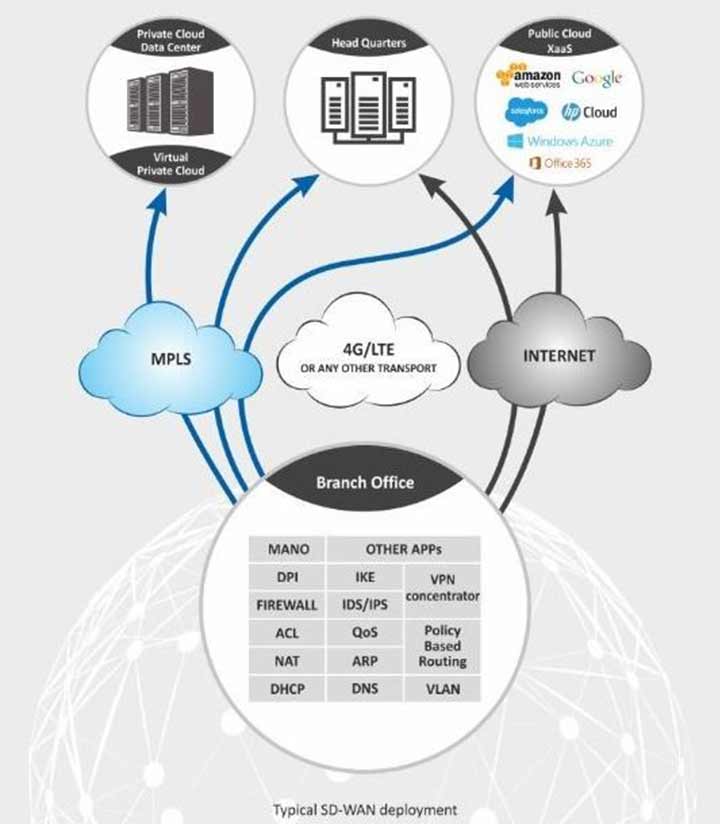

Nithin Babu
SD-WAN and its Benefits
SD-WAN is often confused with its close cousin- Software Defined Networking (SDN). SD-WAN is just focused on WAN, connecting multiple geographically dispersed locations belonging to a single organization (HQ, data centers, branches, remote user, et al) on a regional, national or global basis.
Few common features of SD-WAN and SDN:
- both are designed to run on Commodity X86 hardware,
- both can be virtualized,
- both support additional Virtual Network Functions (VNFs) such as firewall, DPI, etc.,
- Both share a common philosophy – separation of the Control plane and the Data plane.
SDN was designed to meet evolving needs of modern computing environments inside Local Area Networks of an Enterprise or within a Service Provider’s networks. The goal was to create dynamic, flexible, and scalable connectivity to cater to changing demands in the data center. These are the same underlying principles that power SD-WAN. However, it is important to understand the differences too.
Differences between SD-WAN and SDN are:
- SDN is completely programmable by the end-user or customer enabling efficient change and configuration management capabilities. While SD-WAN is built on a common premise of programmability – its forte is that it eliminates the end-user complexity since the programming is handled behind the scenes by the SD-WAN vendor.
- SDN is enabled by Network Function Virtualization (NFV), which provides multiple virtualized network functions via software. These were previously built into proprietary, closed systems that led to vendor lock-ins. In contrast, SD-WAN provides software defined application routing that can be virtualized and run on either an SD-WAN capable appliance or in a virtualized environment/ cloud.
- SDN is used within a data center (also called SDDC) which is a highly controlled environment with significant physical security, high bandwidth, and low latency. Moreover, unless the network has a problem, the bandwidth and latency are constant. In contrast, WAN connections have a high degree of variability. The controller can be in a separate geographical location and may be thousands of miles away from branch locations that are characterized by highly variable latency.
SD-WAN Benefits
SD-WAN offers several benefits such as reduced cost, improved performance, an elastic security perimeter, and shorter deployment timelines compared with traditional, router-based WANs. The emergence of public cloud computing has rendered traditional enterprise WAN architectures to be suboptimal, from a price and performance perspective.
- Truly transformational way to architect, deploy and operate corporate WANs, SD-WAN provides a greatly simplified way of deploying and managing remote branch office connectivity in a cost-effective manner.
- Enables Enterprises to adopt new transport mechanisms as they become available and not get tied down with any specific Vendor or WAN technologies. It is easy to add multiple transports into the mix and manage them as a single fabric as SD-WANs are transport agnostic unlike older WAN solutions.
- Supports policy based WAN optimization by dynamically choosing the correct paths for traffic that is exceedingly complex with traditional hardware. These policies can be created using plain business language & designate allowed paths for specific applications, users, and/or service level agreement (SLA) customer.

Conclusion
Enterprise WAN solutions have changed significantly over the last decade. Basic hub-and-spoke topologies using leased lines, Frame Relay (FR) and Asynchronous Transfer Mode (ATM) architectures were followed by fully mesh MPLS-based solutions. More recently private cloud, public cloud and hybrid models have arrived.
SD-WAN solution allows Enterprises to adopt an intelligent virtual branch router that can support multiple services like application-intelligent policy-based forwarding/routing, higher security and better application performance for the current generation of enterprise end-users. An encrypted overlay creates a unified fabric from a physical underlay that can include private circuits, low-cost Internet broadband, and even LTE.
In conclusion, the following three emerging factors — new application requirements, the increased use of the Internet and the adoption of public cloud services — are driving the need to fully utilize WAN solutions integrating both the Internet and MPLS options simultaneously, as one integrated solution.
